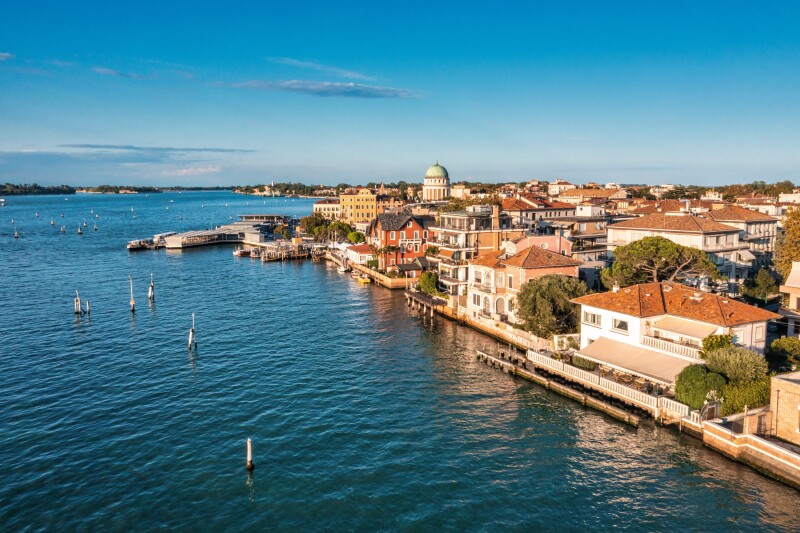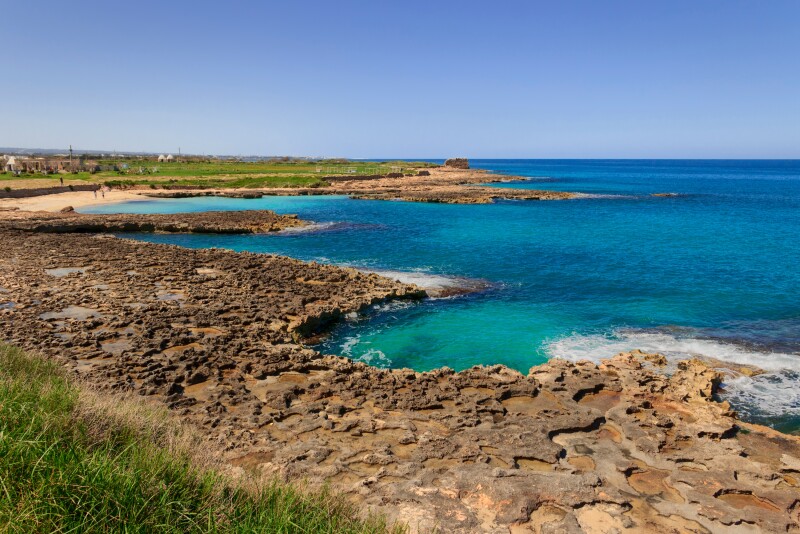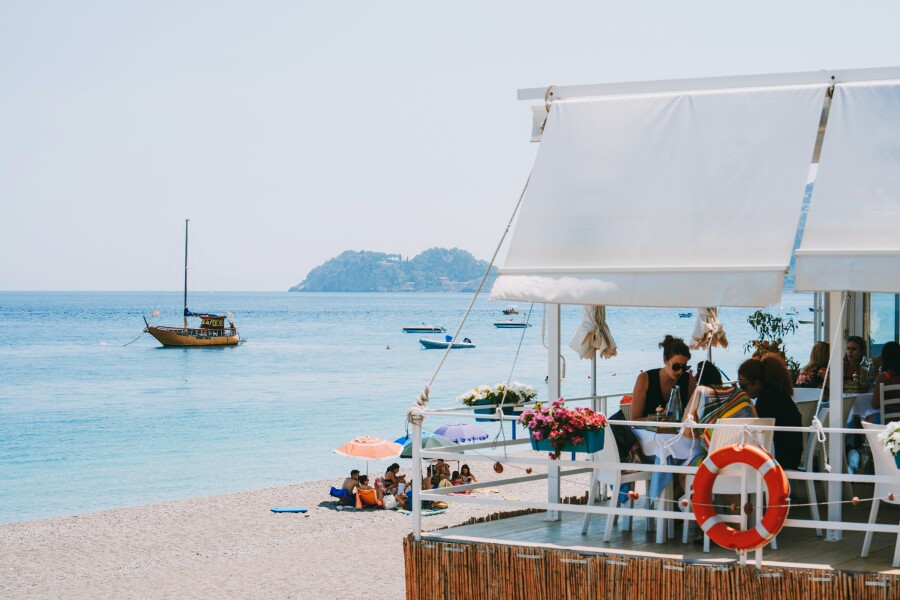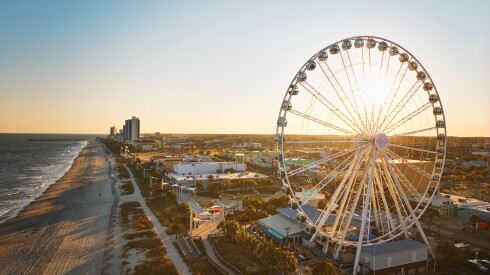My idea of Italian fun is simple: bikini, bicycle, and beach. All I want for a summer sosta (stopover) is to park my bike at the beach’s edge, spend the morning in the waves, and then maybe wander into town for a gelato, an aperitivo, or even an architectural wonder. Italy has no shortage of beautiful beaches, and the more remote, the more beautiful. But what I love most are the seaside towns, where history, sun, and food overlap with a sense of community. From Tuscan promenades and medieval fortresses to art nouveau villas and tiny Sicilian fishing towns, here are the Italian beach towns I know, love, and keep returning to.

In Cecina, a pine forest runs alongside the beach.
Giado/Shutterstock
Cecina, Tuscany
A little more than three hours from Rome, in Tuscany, while chasing Super Tuscan wine in Bolgheri, my husband, an empire-obsessed archaeologist, and I stumbled on Cecina, which seemed like a throwback to an earlier era of seaside living. Marina di Cecina has that classic beach promenade vibe: a strip for strolling and stopping for gelati, spritzes, and spaghetti con vongole (spaghetti with clams). Whether reached by bike or foot, the surprise comes just beyond town in the Tomboli di Cecina Nature Reserve. Known locally as la pineta, this is a beautiful maritime pine forest that runs parallel to the sea, a shaded oasis where cars and motorbikes aren’t allowed. The beaches, as with much of Tuscany’s coast, are a mix of free public stretches and pay-to-enter beach clubs, but the combination of pine-scented paths, seaside strolling, and village atmosphere makes Cecina the quintessential Italian beach town.

Fano was founded by Julius Caesar.
Wirestock Creators/Shutterstock
Fano & Senigallia, Le Marche
Italy is famous for the beach towns on the Adriatic coast, locales planned in the early- to mid-20th century to welcome a new generation of Italian vacationers. As much as I love art deco design, I also adore a little ancient history, and Fano is where the far past and midcentury seaside charm collide. Fano was founded by Julius Caesar as Fanum Fortunae, one of the largest Roman settlements on the Adriatic, and the town’s monumental arch and ancient walls still greet visitors today. Our days here started with early morning espresso on the beach and then were spent biking around town to follow the ancient walls. The coast here is classic Adriatic Italy: miles of long, straight, wide beaches, managed with precision, with rows of umbrellas and loungers stretching to the horizon. From Fano, we pedaled an hour south along the seafront to Senigallia, a livelier spot crowned by a medieval fortress. This is the Adriatic Riviera at its best.

Rocky coves are a hidden aspect of Nervi’s seaside allure.
Photo by Pavlo Baliukh/Shutterstock
Nervi, Liguria
Tucked just south of Genoa, Nervi is a fishing village turned cultural enclave. When I first visited, I came for the art and design: the Wolfsoniana, which houses Italian decorative arts from 1860 to 1930, and the Frugone’s Collection of 19th- and 20th-century paintings and sculptures. But what wooed me was the view from the Passeggiata Anita Garibaldi, a 1.5-mile cliffside promenade with crashing waves on one side and lush gardens on the other. For the sea lovers, there are the rocky coves of Capolungo, tiny and intimate, better suited for plunging into the Ligurian Sea than for sprawling on the sand.

The contrast between chic seafront and the majesty of the Apuan Alps is the central charm of Forte dei Marmi and the Marina di Massa.
Photos by Federico Neri/Shutterstock
Forte dei Marmi and Marina di Massa, Tuscany
I’ll admit, I have done my best to avoid liking Forte dei Marmi. Its reputation as Tuscany’s poshest seaside town made me wary. Then I sat on the sand and looked back at the Apuan Alps, their sharp snow-white peaks framing the background. This is the epitome of mare e montagna (mountain and sea). The draw of this area is owed to more than Forte alone. From Marina di Carrara to Viareggio, the coastline is a cyclist’s dream: long beaches, designated bike paths, and small towns every few kilometers. Forte dei Marmi is undeniably chic, home to high-fashion boutiques, restaurants, and historic beach clubs such as Bagno Alpemare, owned by Andrea Bocelli. Up the road, Massa and Pietrasanta offer a friendlier, (slightly) less flashy vibe while sharing the same spectacular mountain backdrop. The beaches here are akin to California’s central coast, with an Italian bent; you’ll find big skies, long stretches of sand, and gelato shops at every stop. If you’re nearby, don’t miss Gelateria Paradiso in Marina di Carrara.

Come to Letojanni for the small-town vibes—plus the swimming.
Photo by Volker Rauch/Shutterstock
Letojanni, Sicily
Letojanni, north of Taormina, is like a Sicilian postcard from the past. It’s a small town where the beach runs right into the piazza, and life here is as much about conversation as it is about swimming. My Messinese friend, Guido, swears that Ristorante Da Nino is the best fish spot on the island’s eastern coast, and after one meal there, I believe him. The best brioche con gelato I’ve ever had came from Niny Bar, and I enjoyed it while sitting in the piazza in front of the town’s duomo. The beach itself is pebbled, classic Sicily, with crystalline water. From here, it’s a 10-minute drive south to the famous cove of Isola Bella.

Lido is an easygoing island that you can bike through in an hour.
Photo by Pandora Pictures/Shutterstock
Lido, Veneto
Venice is not known for its beaches unless you know where to look. Lido is a long, narrow barrier island stretching seven miles between the lagoon and the Adriatic. Most visitors know it for the Venice Film Festival, but I come for the art nouveau villas, flat bike paths, and year-round seaside vibe. Unlike Venice proper, cars are allowed, but bicycles are the rulers: You can cycle the whole island in under an hour, stopping for swims and spritzes along the way. The town hub is around Gran Viale Santa Maria Elisabetta, but locals head south to Alberoni, a more secluded beach. Lido is Venice’s antidote: casual, sun-washed, and wonderfully unpretentious.

In Savelletri, it’s all about good eating and lazy afternoons.
Photo by Vololibero/Shutterstock
Savelletri, Puglia
Some towns hook me so hard I always find my way back, and Savelletri is one of them. A one-road coastal village halfway between Bari and Brindisi, it’s the kind of place where you eat with your feet in the sea. The rhythm is slow, the vibe is casual, and the food is always the daily catch. North and south of Savelletri are beaches and beach clubs, easy to reach by walking or biking. Those who want more town vibes can Fasano, close by. Still, for me and my husband, it’s Savelletri or bust. This is always our final destination on a summer archeo-road trip in Southern Italy because a 10-minute bike ride up the coast is Egnazia, an ancient Roman city and now an archaeological site.
Don’t Miss
Sperlonga, Lazio:
I have to give a shout-out to the beaches of Lazio. If Sperlonga was good enough for Emperor Tiberius to build his villa here, it’s good enough for me.
Jesolo, Veneto:
A funkier, livelier counterpoint to the Lido. There are bike routes to every stretch of sand, and line up a culinary side trip to Le Cementine, the mainland hideaway of the Michelin wonder brothers from the Alajmo family.
Camogli and San Fruttuoso, Liguria:
Camogli’s pastel facades inspired Pixar’s Luca, and from here you can boat to San Fruttuoso, a hidden cove where a 10th-century abbey sits on the beach.











